
Angus is one of the 32 local government council areas of Scotland, a registration county and a lieutenancy area. The council area borders Aberdeenshire, Dundee City and Perth and Kinross. Main industries include agriculture and fishing. Global pharmaceuticals company GSK has a significant presence in Montrose in the north of the county.

Clan Donnachaidh, also known as Clan Robertson, is a Scottish clan.

Clan Farquharson of Invercauld is a Highland Scottish clan and is a member of Clan Chattan.
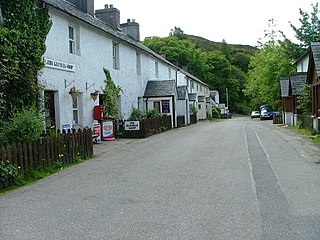
Glenelg (Scottish Gaelic: Glinn Eilg, also Gleann Eilg is a scattered community area and civil parish in the Lochalsh area of Highland in western Scotland. Despite the local government reorganisation the area is considered by many still to be in Inverness-shire, the boundary with Ross-shire being at the top of Mam Ratagan the single track road entry into Glenelg.
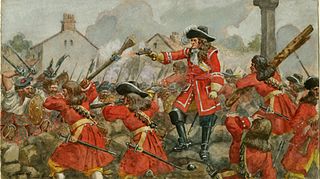
The Battle of Dunkeld was fought between Jacobite clans supporting the deposed king James VII of Scotland and a regiment of covenanters supporting William of Orange, King of Scotland, in the streets around Dunkeld Cathedral, Dunkeld, Scotland, on 21 August 1689 and formed part of the Jacobite rising of 1689, commonly called Dundee's rising in Scotland. The battlefield was added to the Inventory of Historic Battlefields in Scotland in 2012.
John MacDonald, known as Iain Lom was a Scottish Gaelic poet.
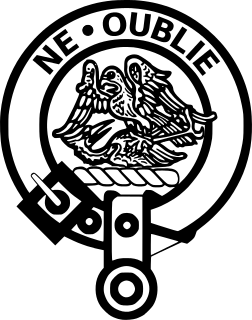
Clan Graham is a Scottish clan who had territories in both the Scottish Highlands and Lowlands.

Dunkeld is a town in Perth and Kinross, Scotland. The location of a historic cathedral, it lies on the north bank of the River Tay, opposite Birnam. Dunkeld lies close to the geological Highland Boundary Fault, and is frequently described as the "Gateway to the Highlands" due to its position on the main road and rail lines north. Dunkeld has a railway station, Dunkeld & Birnam, on the Highland Main Line, and is about 25 kilometres north of Perth on what is now the A9 road. The main road formerly ran through the town, however following modernisation of this road it now passes to the west of Dunkeld.

Inverurie railway station is a railway station serving the town of Inverurie, Aberdeenshire, Scotland. It is managed by ScotRail and is on the Aberdeen to Inverness Line, which is mostly single track north of this point. It is also the terminus for some trains on the Edinburgh and Glasgow Lines through Aberdeen as part of the Aberdeen Crossrail project. The station, Category B listed, is single storied and has a cupola with windvane. The main building, adjacent to the car park to the west, is on platform 1. Inverurie is a busy station with business travellers and commuters, traveling both to and from Aberdeen.

Newtonmore railway station serves the village of Newtonmore, Highland, Scotland. The station is managed by ScotRail and is on the Highland Main Line. The station is 68 miles 62 chains (110.7 km) from Perth, between Dalwhinnie and Kingussie, and has a single platform which is long enough for a ten-coach train. It is currently the only station on the Highland Main Line to have one platform, although the former second platform can still be seen adjacent to the first platform.
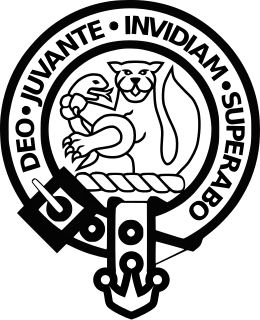
Clan MacThomas is a Highland Scottish clan and is a member of the Clan Chattan.

The Battle of Mulroy was a Scottish clan battle fought in August 1688 in the Lochaber district of Scotland. It was fought between the Clan Mackintosh who were supported by government troops under Kenneth Mackenzie of Suddie against the Clan MacDonald of Keppoch who were supported by the Clan Cameron over disputed lands in the Braes of Lochaber. The battlefield has been inventoried and protected by Historic Scotland under the Scottish Historical Environment Policy of 2009.

The Battle of Clachnaharry was a Scottish clan battle that took place in the year 1454. It was fought between the Clan Munro and the Clan Mackintosh on the south bank of the Beauly Firth at Clachnaharry, on the outskirts of Inverness.

Ashaig is a small township, situated adjacent to Upper Breakish and Lower Breakish near Broadford on the island of Skye, Scotland. For administrative purposes, it lies in the Highland Council area.
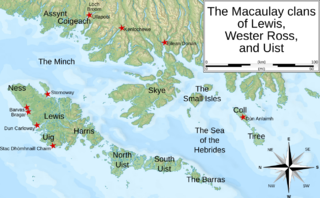
The Macaulay family of Uig in Lewis, known in Scottish Gaelic as Clann mhic Amhlaigh, were a small family located around Uig on the Isle of Lewis in the Outer Hebrides of Scotland. There is no connection between the Macaulays of Lewis and Clan MacAulay which was centred in the Loch Lomond area, bordering the Scottish Highlands and Scottish Lowlands. The Macaulays of Lewis are generally said to be of Norse origin because of the etymology of their surname and also because of the islands' Viking Age past. However, a recent analysis of the Y-DNA of men with Scottish surnames has shown that a large number of Hebridean Macaulays are of Irish origin. In the 17th century, however, tradition gave the Macaulays an Irish origin. By the end of the 16th century the dominant clan on Lewis was Clan Macleod of The Lewes. Other notable Lewis clans were the somewhat smaller Morrisons of Ness and the even less numerous Macaulays of Uig. The Macaulays were centred in the area surrounding Uig on the western coast of Lewis, and had a deadly, long-standing feud with the Morrisons, whose lands were located on the northern coast around Ness. Today the Lewis surname Macaulay is considered to be a sept name of the Macleods of Lewis. There are two other nearby clans of Macaulays who may, or may not, be connected to the Lewis clan—the Wester Ross Macaulays, and the Uist MacAulays.

Redcastle, historically known as Edirdovar and Ederdour, is a mediaeval castle in Killearnan on the Black Isle, northern Scotland. It is so named from the colour of the stone of which it is built. The castle is now in a state of ruinous disrepair, although it is protected as a category B listed building.

Murthly is a village in Perth and Kinross, Scotland. It lies on the south bank of the River Tay, 5 miles southeast of Dunkeld, and 9+1⁄2 miles north of Perth. Perth District Asylum, later known as Murthly Hospital, was opened in the village on 1 April 1864 for 'pauper lunatics'. It was the second district asylum to be built in Scotland under the terms of the 1857 Lunacy (Scotland) Act. It closed in 1984 and was later demolished. The village has a stone circle, in the former grounds of the hospital. The village formerly had a railway station on the Perth and Dunkeld Railway, which closed in 1965.
Coll Macdonald, 16th of Keppoch (c.1664-1729), was a Scottish clan chief and prominent Jacobite, active in both the 1715 Jacobite rebellion and Dundee's rising of 1689. He was chief of the Macdonalds of Keppoch, holding land in Lochaber.
















